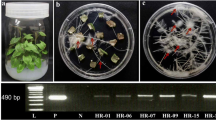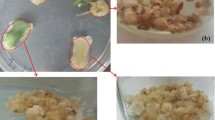Abstract
Transformed hairy root cultures have become an alternative for the biosynthesis of plant secondary metabolites with biological activities. In this present work, the effects of liquid Murashige and Skoog (MS) and Gamborg B5 (B5) medium on kinetic behavior, biomass and phenolic metabolite production were analyzed in Turbinicarpus lophophoroides (Werderm.) Buxb. & Backeb. hairy root cultures. Liquid MS medium showed the highest biomass production (13.67 g L−1 dry weight) after 77 d of culture. For B5 medium, highest biomass was achieved sooner, at day 56, but with lower total biomass (8.10 g L−1 dry weight). After isolation, structural elucidation of the major compound present in T. lophophoroides hairy roots was determined by nuclear magnetic resonance and mass spectral analysis. As a result, a ferulic acid derivative (feruloyl-glucoside) was isolated from T. lophophoroides hairy roots and reported for the first time. Quantitative analysis indicated that feruloyl-glucoside was the major phenolic metabolite at 56 d of growth in MS medium (2.7267 ± 0.041 mg g−1 dry weight L−1) and at 7 and 35 d in B5 medium (2.6328 ± 0.108 and 2.4372 ± 0.026 mg g−1 dry weight L−1, respectively). The feruloyl-glucoside was not detected in untransformed roots (control). The present results suggested the potential of T. lophophoroides hairy roots culture for the production of this phenolic glycoside.





Similar content being viewed by others
References
Abu-Reidah IM, Arráez-Román D, Quirantes-Piné R, Fernández-Arroyo S, Segura-Carretero A, Fernández-Gutiérrez A (2012) HPLC–ESI-Q-TOF-MS for a comprehensive characterization of bioactive phenolic compounds in cucumber whole fruit extract. Food Res Int 46:108–117
Astello-García MG, Cervantes I, Nair V, Santos-Díaz MS, Reyes-Agüero A, Guéraud F, Negre-Salvayre A, Rossignol M, Cisneros-Zevallos L, Barba de la Rosa AP (2015) Chemical composition and phenolic compounds profile of cladodes from Opuntia spp. cultivars with different domestication gradient. J Food Compos Anal 43:119–130
Bokern M, Wray V, Strack D (1991) Accumulation of phenolic acid conjugates and betacyanins, and changes in the activities of enzymes involved in feruloylglucose metabolism in cell-suspension cultures of Chenopodium rubrum L. Planta 184:261–270
Chougui N, Djerroud N, Naraoui F, Hadjal S, Aliane K, Zeroual B, Larbat R (2015) Physicochemical properties and storage stability of margarine containing Opuntia ficus-indica peel extract as antioxidant. Food Chem 173:382–390
Dubois M, Gilles A, Hamilton JK, Rebers PA, Smith F (1956) Colorimetric method for determination of sugars and related substantes. Anal Chem 28:350–356
Gamborg OL, Miller RA, Ojima K (1968) Nutrient requirements of suspension cultures of soybean root cells. Exp Cell Res 50:151–158
Georgiev MI, Agostini E, Ludwig-Muller J, Xu J (2012) Genetically transformed roots: from plant disease to biotechnological resource. Trends Biotechnol 30:528–537
Georgiev MI, Pavlov AI, Bley T (2007) Hairy root type plant in vitro systems as sources of bioactive substances. Appl Microbiol Biotechnol 74:1175
Gómez-Aguirre YA, Zamilpa A, González-Cortazar M, Trejo-Tapia G (2012) Adventitious root cultures of Castilleja tenuiflora Benth. as a source of phenylethanoid glycosides. Ind Crop Prod 36:188–195
Hamada K, Tsutsumi Y, Yamauchi K, Fukushima K, Nishida T (2003) Treatment of poplar callus with ferulic and sinapic acids I: incorporation and enhancement of lignin biosynthesis. J Wood Sci 49:333–338
Jiménez-Aspee F, Quispe C, Soriano MPC, Fuentes Gonzalez J, Hüneke E, Theoduloz C, Schmeda-Hirschmann G (2014) Antioxidant activity and characterization of constituents in copao fruits (Eulychnia acida Phil., Cactaceae) by HPLC–DAD–MS/MSn. Food Res Int 62:286–298
Kim JW, Kim TB, Yang H, Sung SH (2016) Phenolic compounds isolated from Opuntia ficus-indica fruits. Nat Prod Sci 22:117–121
Kovács Z, Dinya Z (2000) Examination of non-volatile organic compounds in red wines made in Eger. Microchem J 67:57–62
Lin LZ, Harnly JM (2010) Phenolic component profiles of mustard greens, yu choy, and 15 other Brassica vegetables. J Agric Food Chem 58:6850–6857
Lucini L, Rocchetti G, Kane D, Trevisan M (2017) Phenolic fingerprint allows discriminating processed tomato products and tracing different processing sites. Food Control 73:696–703
Ludwig-Muller J, Jahn L, Lippert A, Puschel J, Walter A (2014) Improvement of hairy root cultures and plants by changing biosynthetic pathways leading to pharmaceutical metabolites: strategies and applications. Biotechnol Adv 32:1168–1179
Madala NE, Steenkamp PA, Piater LA, Dubery IA (2014) Metabolomic insights into the bioconversion of isonitrosoacetophenone in Arabidopsis thaliana and its effects on defense-related pathways. Plant Physiol Biochem 84:87–95
Matkowski A (2008) Plant in vitro culture for the production of antioxidants - a review. Biotechnol Adv 26:548–560
Mehrotra S, Srivastava V, Ur Rahman L, Kukreja AK (2015) Hairy root biotechnology--indicative timeline to understand missing links and future outlook. Protoplasma 252:1189–1201
Murashige T, Skoog F (1962) A revised medium for rapid growth and bio assays with tobacco tissue cultures. Physiol Plant 15:473–497
Palomeque-Carlín A, Tafoya F, Alpuche Solís AG, Pérez-Molphe-Balch E (2015) Effects of different culture media and conditions on biomass production of hairy root cultures in six Mexican cactus species. In Vitro Cell Dev Biol–Plant 51:332–339
Pérez-Ilzarbe J, Hernández T, Estrella I (1991) Phenolic compounds in apples: varietal differences. Z Lebensm Unters Forsch 192:551–554
Pérez-Molphe-Balch E, Santos-Díaz MS, Ramírez-Malagón R, Ochoa-Alejo N (2015) Tissue culture of ornamental cacti. Sci Agric 72:540–561
Russowski D, Maurmann N, Rech SB, Fett-Neto AG (2006) Role of light and medium composition on growth and valepotriate contents in Valeriana glechomifolia whole plant liquid cultures. Plant Cell Tissue Organ Cult 86:211–218
Semarnat (2010) Protección ambiental-Especies nativas de México de flora y fauna silvestres-Categorías de riesgo y especificaciones para su inclusión, exclusión o cambio-Lista de especies en riesgo. NOM-059-SEMARNAT-2010. Diario oficial de la federación, México, pp. 1–78
Smith M, Fitz Maurice WA, Fitz Muarice B, Sotomayor M (2013) Turbinicarpus lophophoroides, Biznaguita. The IUCN red list of threatned species, 10.2305/IUCN.UK.2013-1.RLTS.T40981A2949100.en. Accessed 6/29/18
Štarha R, Chybidziurová A, Lacný Z (1999) Alkaloids of the genus Turbinicarpus (Cactaceae). Biochem Syst Ecol 27:839–841
Tang X, Olatunji OJ, Zhou Y, Hou X (2017) Allium tuberosum: antidiabetic and hepatoprotective activities. Food Res Int 102:681–689
Tanimoto S, Tominaga H, Okada Y, Nomura K (2006) Synthesis and cosmetic whitening effect of glycosides derived from several phenylpropanoids. Yakugaku Zasshi 126:173–177
Trejo-Moreno C, Méndez-Martínez M, Zamilpa A, Jimenez-Ferrer E, Perez-Garcia MD, Medina-Campos ON, Pedraza-Chaverri J, Santana MA, Esquivel-Guadarrama FR, Castillo A, Cervantes-Torres J, Fragoso G, Rosas-Salgado G (2018) Cucumis sativus aqueous fraction inhibits angiotensin II-induced inflammation and oxidative stress in vitro. Nutrients 10:1–14
Villaseñor JL (2016) Checklist of the native vascular plants of Mexico. Rev Mex Biodivers 87:559–902
Wagner H, Bladt S (1996) Plant drug analysis: a thin layer cromatography atlas. Springer, Berlin
Weremczuk-Jeżyna I, Grzegorczyk-Karolak I, Frydrych B, Krolicka A, Wysokińska H (2013) Hairy roots of Dracocephalum moldavica: rosmarinic acid content and antioxidant potential. Acta Physiol Plant 35:2095–2103
Wu CH, Dewir YH, Hahn EJ, Paek KY (2006) Optimization of culturing conditions for the production of biomass and phenolics from adventitious roots of Echinacea angustifolia. Journal of Plant Biology 49:193–199
Funding
This work was supported by the Departamento de Apoyo a la Investigación de la Universidad Autónoma de Aguascalientes (UAA) (Grants PIBT16-16). G.J. Solis-Castañeda is indebted to Consejo Nacional de Ciencia y Tecnología (CONACyT-México) for the doctoral fellowship awarded. Y.A. Gómez-Aguirre is grateful to Cátedras-CONACyT.
Author information
Authors and Affiliations
Corresponding author
Ethics declarations
Conflict of interest
The authors declare that they have no conflict of interest.
Additional information
Editor: Praveen Saxena
Electronic supplementary material
Figure S1.
Full mass spectrometry scan data in negative ion mode of Peak 1 (m/z 355.1) of Turbinicarpus lophophoroides (Werderm.) Buxb. & Backeb. hairy roots cultures grown in liquid Murashige and Skoog (MS; Murashige and Skoog 1962) at 56 d (exponential growth phase) (PNG 111 kb)
Rights and permissions
About this article
Cite this article
Solis-Castañeda, G.J., Zamilpa, A., Cabañas-García, E. et al. Identification and quantitative determination of feruloyl-glucoside from hairy root cultures of Turbinicarpus lophophoroides (Werderm.) Buxb. & Backeb. (Cactaceae). In Vitro Cell.Dev.Biol.-Plant 56, 8–17 (2020). https://doi.org/10.1007/s11627-019-10029-z
Received:
Accepted:
Published:
Issue Date:
DOI: https://doi.org/10.1007/s11627-019-10029-z




